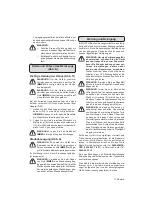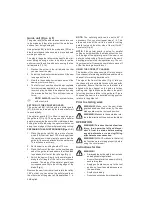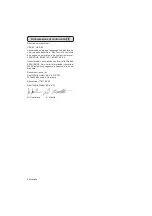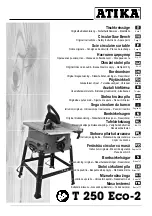
21-English
system will run eccentrically, causing loss of
control.
h)
Never use damaged or incorrect blade wash-
ers or the wrong securing bolt.
The blade
washers and bolt were especially designed for
your saw to ensure optimum performance and
safe operation.
i)
Always position your body so that it to one
side of the saw and not in line with the saw.
KICKBACK could cause the saw to jump back-
wards (see "Causes and Prevention of kickback
by the operator").
j)
BEWARE!
Saw blades continue to coast after
switching off until they fi nally stop. Serious
personal injury may result from this.
k)
Avoid cutting nails. Inspect for nails fi rst
and remove any that you fi nd before cutting
lumber.
Causes and prevention of kickback
by the operator
– A kickback is a sudden reaction to a jammed,
bound or bent saw blade. If this happens the
saw will become uncontrollable and it will lever
itself out of the workpiece and lurch backwards
towards the operator.
– When the blade is pinched or bound by the
kerf closing down, it then stalls and the motor
reaction drives the saw rapidly back toward the
operator.
– If the blade becomes twisted or misaligned in
the cut, the teeth at the back edge of the blade
can dig into the top surface of the wood and this
causes the blade to climb out of the kerf and
jump back toward the operator.
Kickback is the result of saw misuse and/or incor-
rect operating procedures or conditions and can
be avoided by taking proper precautions as listed
below:
a)
Maintain a fi rm grip with both hands on
the saw and position your arms to resist
the kickback force. Position your body on
either side of the blade, but not in line with
the blade.
Kickback could cause the saw to
jump backwards, but the kickback force can be
controlled by the operator if proper precautions
are taken. The kickback force can be controlled
by the operator if the relevant precautions are
taken.
b)
Release the trigger switch if the saw blade
jams in place or if the cutting has to be
interrupted for a any reason. Hold the saw
away from the material until the saw blade
stops fi nally stops. Never attempt to remove
the saw from the workpiece or pull the saw
backward while the blade is moving or kick-
back may occur. A kickback might occur if
you attempt to remove it.
Investigate and take
corrective action to eliminate the cause of blade
binding.
c)
Centre the saw blade in the kerf and check
that saw teeth are not engaged in the materi-
al when restarting a saw in the workpiece.
If
saw blade is binding, it may walk up or kickback
from the workpiece when the saw is restarted.
d)
Support large wooden panels to minimise
the risk of blade pinching and kickback.
Large panels tend to sag under their own
weight. Supports must be placed under the
panel on both sides, near the line of cut and
near the edge of the panel.
e)
Never use blunt or damaged saw blades.
Blunt or incorrectly set blades will produce a
narrow kerf. This will cause excessive friction,
blade binding and a kickback.
f)
Blade depth and bevel adjusting locking
levers must be tight and secure before start-
ing the cut.
If blade adjustment shifts during
cutting it might cause binding and a kickback.
g)
Take extra care when making a “plunge cut”
into existing walls or other blind areas.
The
protruding saw blade may cut into objects that
can cause a kickback.
Lower guard safety instructions
a)
Always check the lower guard before using
the saw. Never use the saw if lower guard
does not move freely and close instantly.
Never clamp or tie the lower guard into
the open position.
The lower guard might be
bent if the saw is accidentally dropped. Use the
retracting handle to raise the lower guard and
make sure it moves freely and does not touch
the blade or any other part at any angle or cut-
ting depth.
b)
Check the operation of the lower guard
spring. The guard and the spring must be
serviced before use if they are not operating
properly.
Lower guard may operate sluggishly
due to damaged parts, gummy deposits or a
build-up of debris.
c)
Lower guard should only be retracted manu-
ally for special cuts such as “plunge cuts”
and “compound cuts”. Pull the retracting
handle to raise the lower guard. Release
the lower guard as soon as the saw blade
touches the material.
The lower guard should
operate automatically for all other saw cuts.
Содержание HKS 52
Страница 3: ...15 16 6 7 8 9 10 3 1 11 14 2 1 17 2 1 3 4 6 7 8 12 11 9 10 15 5 16 13 14 4 17 29 29 29 29 5 12 ...
Страница 4: ...6 11 max ...
Страница 5: ...8 9 21 7 10 20 19 22 7 12 18 23 6 ...
Страница 6: ...24 26 25 28 24 15 mm 100 mm 27 24 ...
Страница 7: ......
Страница 8: ...27 27 45 0 ...
Страница 9: ...25 29 3 15 16 ...
Страница 224: ......
















































